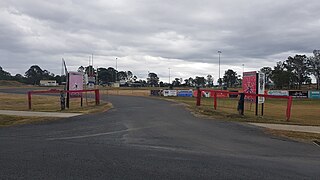Related Research Articles

The Wonnarua people, otherwise written Wanarruwa, are a group of Aboriginal Australian people united by strong ties of kinship, and who survived in family groups or clans scattered along the inland area of what is now known as the Upper Hunter Valley, New South Wales, Australia. Their creation spirit is Baiami, also known as Koin, the creator of all things and the Keeper of the Valley.
Darkinjung is an Australian Aboriginal language, the traditional language of the Darkinjung people. While no audio recordings of the language survive, several researchers have compiled wordlists and grammatical descriptions. It has been classified as a language no longer fully spoken and it can be classified as needing a language renewal program. It was spoken adjacent to Dharuk, Wiradhuri, Guringai, Gamilaraay, and Awabakal. The Darkinjung tribe occupied a small part of southeastern Australia inside what is now the New South Wales area. They likely inhabited a considerable tract of land within Hunter, Northumberland, and Cook counties.
The Gathang language, also spelt Gadjang, Kattang, Kutthung, Gadhang, Gadang and previously known as Worimi language, is an Australian Aboriginal language or group of dialects. The three known dialects are Birrbay, Guringay, and Warrimay, which are used by the Worimi, Guringay, and Birrbay peoples. It became dormant during the latter half of the 20th century, but has been revived during the 21st century.

Gumbaynggir language is an Australian Aboriginal language spoken by the Gumbaynggirr people, who are native to the Mid North Coast of New South Wales.
Bidjara, also spelt Bidyara or Pitjara, is an Australian Aboriginal language. In 1980, it was spoken by 20 elders in Queensland between the towns of Tambo and Augathella, or the Warrego and Langlo Rivers. There are many dialects of the language, including Gayiri and Gunggari. Some of them are being revitalised and are being taught in local schools in the region. The various dialects are not all confirmed or agreed by linguists.
Dhauwurd Wurrung is a term used for a group of languages spoken by various groups of the Gunditjmara people of the Western District of Victoria, Australia. Keerray Woorroong is regarded by some as a separate language, by others as a dialect. The dialect continuum consisted of various lects such as Kuurn Kopan Noot, Big Wurrung, Gai Wurrung, and others. There was no traditional name for the entire dialect continuum and it has been classified and labelled differently by different linguists and researchers. The group of languages is also referred to as Gunditjmara language and the Warrnambool language.
Guugu Yalandji, also spelt Kuku-Yalanji, is an Australian Aboriginal language of Queensland. It is the traditional language of the Kuku Yalanji people.
Biri, also known as Biria, Birri Gubba, Birigaba, Wiri, Perembba and other variants, is an Australian Aboriginal language of the Mackay area of Queensland spoken by the Birri Gubba people. There are at least eight languages regarded as dialects of Biri, and two which are related but whose status is not yet fully determined. All are covered in this article.
Kungkari is an extinct and unclassified Australian Aboriginal language. The Kungkari language region included the landscape within the local government boundaries of the Longreach Shire Council and Blackall-Tambo Shire Council.
Bigambal is an extinct and unclassified Australian Aboriginal language from the Pama–Nyungan language family. The Bigambul language region includes the landscape within the local government boundaries of the Goondiwindi Regional Council, including the towns of Goondiwindi, Yelarbon and Texas extending north towards Moonie and Millmerran. The AUSTLANG database maintained by the Australian Institute of Aboriginal and Torres Strait Islander Studies states that the Bigambal language was spoken by the Bigambul people, with Gambuwal and Kwiambal known dialects. However, it is likely that the Gamilaraay language was used by those peoples living in southern Bigambul territory.

Tweed Heads West is a suburb of Tweed Heads, located on the Tweed River in north-eastern New South Wales, Australia, in Tweed Shire along the Queensland and New South Wales border.
Marbal (Marbul) is a dialect of the Yugambal language that was spoken around Tenterfield in northern New England, Australia.
Cobaki Lakes is a suburb of Tweed Heads, located in the Northern Rivers Region of New South Wales, along the Queensland and New South Wales border.
Waalubal (Wahlubal), also known as Western Bundjalung, Baryulgil, and Middle Clarence Bandjalang, is an Australian Aboriginal language spoken by the Western Bundjalung living in North-East New South Wales.

Flinders Lakes is a rural locality in the City of Logan, Queensland, Australia. It was gazetted in May 2016.

Monarch Glen is a rural locality in the City of Logan, Queensland, Australia. It is situated along the development corridor south of Brisbane in the Greater Flagstone development area

Glenlogan is a rural locality in the City of Logan, Queensland, Australia. It is part of the suburban development corridor south of Brisbane in the Greater Flagstone development area.
Silverbark Ridge is a rural locality in the City of Logan, Queensland, Australia. It is situated along the development corridor south of Brisbane in the Greater Flagstone development area and expected to become a residential area as the city's population increases.
Muurrbay Aboriginal Language and Culture Co-operative is a language revitalisation centre for Aboriginal Australian languages of a region in New South Wales, situated in Nambucca Heads.
References
- ↑ E10 Yaygir language at the Australian Indigenous Languages Database, Australian Institute of Aboriginal and Torres Strait Islander Studies
- ↑ E10 Yaygir at the Australian Indigenous Languages Database, Australian Institute of Aboriginal and Torres Strait Islander Studies
- ↑ Morelli, Steve (2012). Yaygirr Dictionary and Grammar. Nambucca Heads: Muurrbay Aboriginal Language and Culture Co-operative . Retrieved 31 July 2012.
- 1 2 Morelli, Steve (2012). Yaygirr Dictionary and Grammar. Nambucca Heads: Muurrbay Aboriginal Language and Culture Co-operative . Retrieved 12 December 2023.
- ↑ "Yaygirr". Muurrbay Aboriginal Language and Culture Co-operative. Retrieved 25 March 2024.